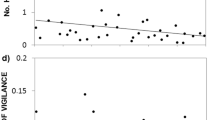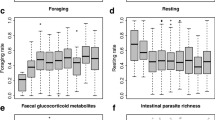Abstract
Primate social grouping is understood as an adaptive strategy for mitigating environmental selection pressures, but the relative importance of various pressures may vary. Physiological measures of well-being can show their short-term impacts and suggest their relative importance and capacity to provide ultimate or proximate control of group size. I examined correlations between pressures commonly proposed as causes of social grouping (foraging success, intergroup and intragroup agonism, and predation risk) and individual levels of fecal cortisol, a hormonal stress measure, in a free-ranging population of Lemur catta. I collected behavioral data on 45 female Lemur catta at Berenty Reserve, Madagascar, over 3 seasons (August 1999-July 2000) and determined individual cortisol levels from 474 fecal samples. Neither predator alarm rates nor intragroup agonism rates correlated with cortisol levels in any season. However, females with low daily food intake and high rates of escalated intergroup defense exhibited higher cortisol levels. The data suggest that acquisition and defense of food resources are principal challenges in Lemur catta, and may be important factors determining social grouping and other behavioral or life history adaptations.
Similar content being viewed by others
References
Alberts, S. C., Sapolsky, R. M., and Altmann, J. (1992). Behavioral, endocrine, and immunological correlates of immigration by an aggressive male into a natural primate group. Horm. Behav. 26: 167–178.
Altmann, J. (1974). Observational study of behavior: sampling methods. Behaviour 49: 227–265.
Altmann, S. A. (1998). Foraging for Survival, Univ. of Chicago Press, Chicago.
Bradley, A. J. (1980). Stress and mortality in a small marsupial (Antechinus stuartii, Macleay). Gen. Comp. Endocrinol. 40: 188–200.
Cavigelli, S. A. (1998). Fecal cortisol levels relative to behavior in a free-ranging primate: adaptive aspects of a glucocorticoid hormone. PhD dissertation, Duke University.
Cavigelli, S. A. (1999). Behavioural patterns associated with faecal cortisol levels in free-ranging female ring-tailed lemurs, Lemur catta. Anim. Behav. 57: 935–944.
Cavigelli, S. A., Dubovick, T., Levash, W., Jolly, A., and Pitts, A. (2003). Female dominance status and fecal corticoids in a cooperative breeder with low reproductive skew: ring-tailed lemurs (Lemur catta). Horm. Behav. 43: 166–179.
Chapman, C. A., and Chapman, L. J. (2000). Determinants of group size in primates: the importance of travel costs. In Boinski, S. (ed.), On the Move, Univ of Chicago Press, Chicago.
Creel, S. (2001). Social dominance and stress hormones. Trends in Ecol. Evol. 19: 491–497.
Foley, C. A. H., Papageorge, S., and Wasser, S. K. (2001). Noninvasive stress and reproductive measures of social and ecological pressures in free-ranging African elephants. Conserv. Biol. 15: 1134–1142.
Hofer, H., and East, M. L. (1998). Biological Conservation and Stress. Adv. Stud. Behav. 27: 405–525.
Jolly, A. (1966). Lemur behavior: a Madagascar field study, University of Chicago Press, Chicago.
Jolly, A. (1984). The puzzle of female feeding priority. In Small, M. F. (ed.), Female primates: studies by women primatologists, Alan R. Liss, New York, pp. 197–215.
Jolly, A., Caless, S., Cavigelli, S., Gould, L., Pereira, M. E., Pitts, A., Pride, R. E., Rabenandrasana, H. D., Walker, J. D., and Zafison, T. (2000). Infant killing, wounding, and predation in Eulemur and Lemur. Int. J. Primat. 21: 21–40.
Jolly, A., Dobson, A., Rasamimanana, H. M., Walker, J., O’Connor, S., Solberg, M., and Perel, V. (2002). Demography of Lemur catta at Berenty Reserve, Madagascar: Effects of troop size, habitat, and rainfall. Int. J. Primatol. 23: 327–355.
Jolly, A., and Pride, E. (1999). Troop histories and range inertia of Lemur catta at Berenty, Madagascar: a 33-year perspective. Int. J. of Primat. 20: 359–373.
Jolly, A., Rasamimanana, H. R., Kinnaird, M. F., O’Brien, T. G., Crowley, H. M., and Harcourt, C. S. (1993). Territoriality in Lemur catta groups during the birth season at Berenty, Madagascar. In Kappeler, P. M., and Ganzhorn, J. U. (eds.), Lemur social systems and their ecological basis, Plenum, New York, pp. 85–109.
Jones, K. C. (1983). Inter-group transfer of Lemur catta at Berenty, Madagscar. Folia Primatol. 40: 145–160.
Judge, P. G., and de Waal, F. B. M. (1997). Rhesus monkey behaviour under diverse population densities: coping with long-term crowding. Anim. Behav. 54: 643–662.
Kappeler, P. M. (1990). Female dominance in Lemur catta: more than just female feeding priority? Folia Primatol. 55: 92–95.
Kappeler, P. M. (1993). Reconciliation and post-conflict behavior in ringtailed lemurs, Lemur catta, and redfronted lemurs, Eulemur fulvus. Anim. Behav. 45: 901–915.
Maynard Smith, J., and Parker, G. A. (1976). The logic of asymmetric contests. Anim. Behav. 24: 159–175.
Mertl-Millhollen, A. S. (1988). Olfactory demarcation of territorial but not home range boundaries by Lemur catta. Folia Primatol. 50: 175–187.
Palagi, E., Paoli, T., and Tarli, S. B. (2005). Aggression and reconciliation in two captive groups of Lemur catta. Int. J. Primat. 26: 279–294.
Parker, G. A., and Rubenstein, D. I. (1981). Role assessment, reserve strategy, and acquisition of information in asymmetric animal conflicts. Anim. Behav. 29: 221–240.
Pereira, M. E. (1993). Agonistic interaction, dominance relation, and ontogenic trajectories in ringtailed lemurs. In Pereira, M. E., and Fairbanks, L. A. (eds.), Juvenile Primates: Life history, development, and behavior, Oxford University Press, New York, pp. 285–305.
Pereira, M. E., and Kappeler, P. M. (1997). Divergent systems of agonistic behavior in lemurid primates. Behaviour 134: 225–274.
Pereira, M. E., Strohecker, R. A., Cavigelli, S. A., Hughes, C. L., and Pearson, D. D. (1999). Metabolic strategy and social behavior in Lemuridae. In Rakotosamimanana, B., Rasamimanana, H., Ganzhorn, J. U., and Goodman, S. M. (eds.), New directions in lemur studies Kluwer Academic/Plenum Publishers, New York.
Pride, R. E. (in press). High faecal glucocorticoid levels predict mortality in ring-tailed lemurs (Lemur catta). Biol. Lett.
Ray, J. C., and Sapolsky, R. M. (1992). Styles of male social behavior and their endocrine correlates among high-ranking wild baboons. Am. J. Primatol. 28: 231–250.
Romero, L. M., and Wikelski, M. (2001). Corticosterone levels predict survival probabilities of Galapagos marine iguanas during El Nino events. Proc. Nat. Acad. Sci. 98: 7366–7370.
Rubenstein, D. I. (1981). Population density, resource patterning, and territoriality in the Everglades pygmy sunfish. Anim. Behav. 29: 155–172.
Rubenstein, D. I., and Wrangham, R. W. (eds.) (1982). Ecological aspects of Social Evolution: Birds and Mammals. Princeton: Princeton University Press.
Sapolsky, R. M. (1986). Endocrine and behavioral correlates of drought in the wild baboons. Am. J. Primatol. 11: 217–226.
Sapolsky, R. M. (1992). Neuroendocrinology of the stress-response. In Becker, J. B., Breedlove, S. M., and Crews, D. (eds.), Behavioral endocrinology, The MIT Press, Cambridge, pp. 287–324.
Sapolsky, R. M., and Ray, J. (1989). Styles of dominance and their endocrine correlates among wild olive baboons (Papio anubis). Am. J. Primatol. 18: 1–13.
Sapolsky, R. M., Romero, L. M., and Munck, A. U. (2000). How do glucocorticoids influence stress responses? Integrating permissive, suppressive, stimulatory, and preparative actions. Endocr. Rev. 21: 55–89.
Sauther, M. L. (1989). Antipredator behavior in troops of free-ranging Lemur catta at Beza-Mahafaly Special Reserve, Madagascar. Int. J. Primat. 10: 595–606.
Sauther, M. L. (1993). The dynamics of feeding competition in wild populations of ringtailed lemurs (Lemur catta). In Kappeler, P. M., and Ganzhorn, J. (eds.), Lemur social systems and their ecological basis Plenum, New York, pp. 135–152.
Sauther, M. L., Sussman, R. W., and Gould, L. (1999). The socioecology of the ringtailed lemur: thirty-five years of research. Evol. Anthropol. 8: 120–132.
Scheuerlein, A., Van’t Hof, T. J., and Gwinner, E. (2001). Predators as stressors? Physiological and reproductive consequences of predation risk in tropical stonechats (Saxicola torquata axillaris). Proc. Roy. Soc. B 268: 1575–1582.
Selye, H. (1973). The evolution of the stress concept. Am. Sci. 61: 692–699.
Terborgh, J. (1983). Five new world primates: A study in comparative ecology, Princeton University Press, Princeton.
Terborgh, J., and Janson, C. H. (1986). The socioecology of primate groups. Ann. Rev. Ecol. Syst. 17: 111–135.
van Schaik, C. P. (1983a). On the ultimate causes of primate social systems. Behaviour 85: 91–117.
van Schaik, C. P. (1983b). Why are diurnal primates living in groups? Behaviour 87: 120–144.
van Schaik, C. P. (1989). The ecology of social relationships amongst female primates. In Standen, V., and Foley, R. A. (eds.), Comparative socioecology: the behavioral ecology of humans and other mammals Blackwell Scientific, Boston, pp. 195–218.
Wasser, S. K., Hunt, K. E., Brown, J. L., Cooper, C., Crockett, C. M., Bechert, U., Millspaugh, J. J., Larson, S., and Monfort, S. L. (2001). A generalized fecal glucocorticoid assay for use in a diverse array of non-domestic mammalian and avian species. Gen. Comp. Endo. 120: 260–275.
Wikelski, M., Wong, V., Chevalier, B., Rattenberg, N., and Snell, H. (2002). Galapagos Islands: Marine iguanas die from trace oil pollution. Nature 417: 607.
Wingfield, J. C., Hunt, K., Breuner, C., Dunlap, K., Fowler, G. S., Freed, L., and Lepson, J. (1997). Environmental stress, field endocrinology, and conservation biology. In Clemmons, J. R., and Buchholz, R., (eds.), Behavioral approaches to conservation in the wild, Cambridge Univ. Press, Cambridge, pp. 95–131.
Wingfield, J. C., Maney, D. L., Breuner, C. W., Jacobs, J. D., Lynn, S., Ramenofsky, M., and Richardson, R. D. (1998). Ecological bases of hormone-behavior interactions: the “emergency life-history stage.” Am. Zool. 38: 191–206.
Wrangham, R. W. (1980). An ecological model of female-bonded primate groups. Behaviour 75: 262–300.
Author information
Authors and Affiliations
Corresponding author
Rights and permissions
About this article
Cite this article
Pride, R.E. Foraging Success, Agonism, and Predator Alarms: Behavioral Predictors of Cortisol in Lemur catta . Int J Primatol 26, 295–319 (2005). https://doi.org/10.1007/s10764-005-2926-9
Received:
Revised:
Accepted:
Issue Date:
DOI: https://doi.org/10.1007/s10764-005-2926-9




